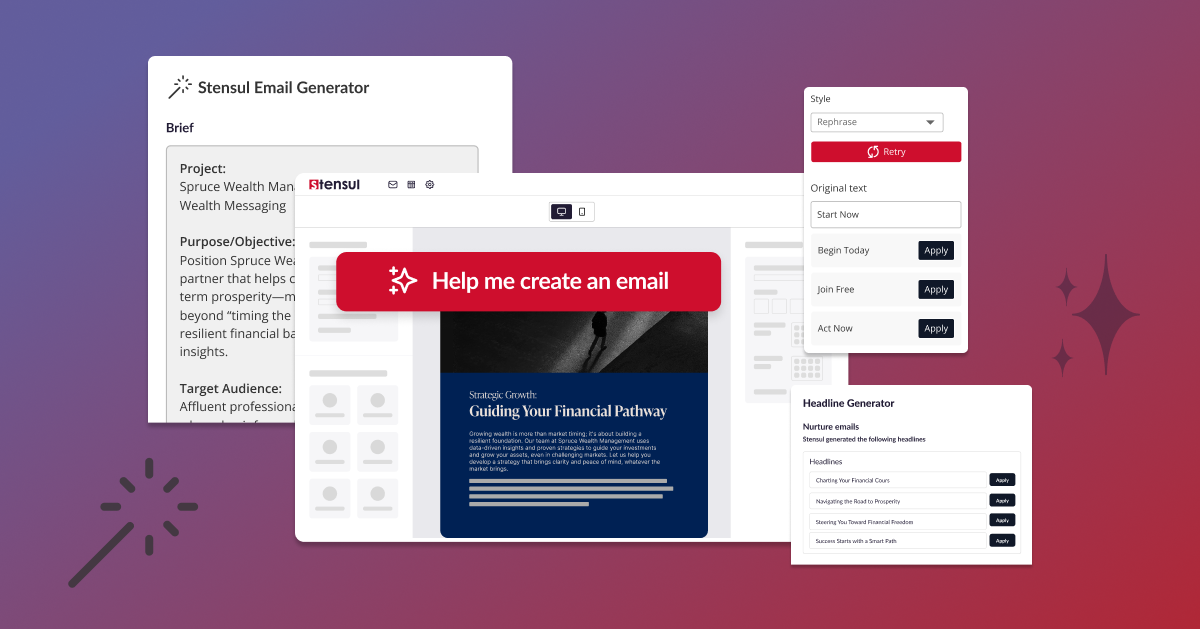Have you ever posted to Instagram only to have your post instantly buried by a slew of ads, suggested posts, and other inexplicable memes? As algorithms become less and less predictable, marketers turn back to a reliable channel: email.
Email remains a highly effective, cost-efficient, and scalable channel for driving engagement, conversions, and customer retention. What’s more, the average ROI of of email marketing still hovers around 42–45 for every $1 spent.
The email creation process conundrum
While marketers see email as more crucial than even social media, unfortunately, many are dealing with an email creation process that’s far from efficient. A Stensul survey among companies, from mid-market to enterprise level, across all industry sectors, found it took email teams two or more weeks to get a single HTML email deployed.
That is one serious contradiction: The best-performing digital communications vehicle takes longer and is more challenging to create than any other for several reasons.
It’s for that very reason that marketers should look to change their email creation process. The Creation Operating Models that so many teams have leveraged for years (and still do) weren’t built for today’s marketing needs, including the advancement of AI-led creation. Bottom line: Tech evolves at breakneck speed, leading to faster creation. But the Creation Operating Models behind campaign creation remain stuck in the past.
It’s that very disconnect that’s costing brands time, talent, and trust.

So, why should a team look to change their email creation process? Let’s break it down.
1. Emails take too long to produce
Email’s ability to produce spectacular results is a testimony to the dedication and perseverance of email teams, likely yours too. Respondents to a recent survey among email marketers and marketing operations (MOPs) pros said emails take too long to move through the production cycle, resulting in a painful email creation process. Depending on the team, SLA’s can be anywhere from 7 days to two or more weeks for a single email. This process does not allow for agility or timeliness.
2. There are too many bottlenecks
The email creation process used by most organizations involves specialists operating in silos using single-purpose tools. There’s lots of back-and-forth marked with frequent and severe bottlenecks that stretch a blood-pressure-raising workflow even more. On top of that, the emails produced often have deliverability or accessibility issues as well as being off-brand and not properly compliant with regulatory requirements.
There’s an excellent chance members of your team overseeing email creation are understaffed and overworked. The reason might just be the way they have to create emails. Given that situation, it should not surprise that an analysis of thousands of email creation efforts found that teams spent 90% of their time tackling production-related activities. That left just 10% of allocated time for performance-boosting activities like A/B testing, strategy refinement, and personalization.
3. Budgets are too tight
As much as marketing leaders would love to do so, the solution is not to hire more people to create the emails that need to be prepared and deployed. That just makes a highly inefficient process more expensive. If you can find even some of these challenges to email creation efficiency in your process, that is reason enough for you to manage a change to your email creation process.
The solution: A new Creation Operating Model
In order to address those three issues and built an email creation process ready for the marketing world of today, teams must look to instill intentional architecture: Creation Operating Models that are built for speed and control.
To help teams unlock the first step of this: We crafted the SPEED Framework as a pragmatic roadmap for transformation.
Take a peek at our proven SPEED Workflow Audit (download PDF) infographic to unblock your workflow today.
S: Scan the Current Workflow
Document who’s involved, where delays happen, and how long handoffs take-from brief to send.
P: Pinpoint Bottlenecks
With that visualized workflow, use 🔴🟡🟢 to flag friction points and expose where work gets stuck.
E: Evaluate the Economic Impact
Calculate hidden costs: lost hours, missed deadlines, and wasted resources.
E: Expose Opportunities for Adding AI
Identify where you can add AI to unlock the most value.
D: Define Guardrails
Rethink governance (the why/what/where/how) to empower the wider team.
To see an efficient email creation process in action, request your personal Stensul demo here.


